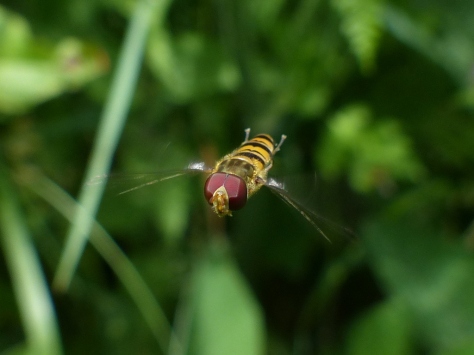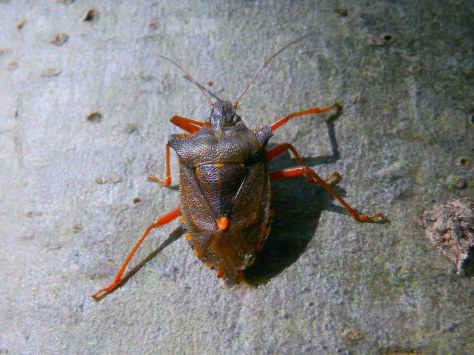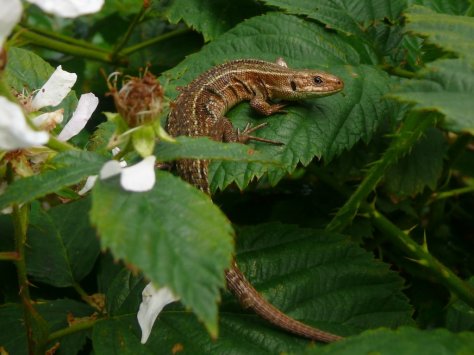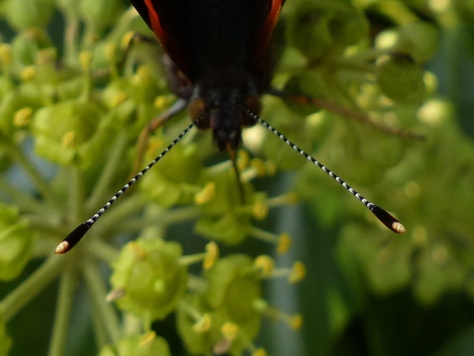This is where it gets a little bit intimidating.
I am a bit of a one trick pony. I photograph nature. My camera is nearly always hand held and everything moves so I have to be fast.
The first trick that I learnt was to drop my exposure a couple of clicks. On my first camera (Panasonic FZ50) I could do that whilst leaving the camera in intelligent auto mode.
It was the only thing that I knew how to do and I took these photographs.
 I was happy and encouraged. I took hundreds of pictures like these.
I was happy and encouraged. I took hundreds of pictures like these.
As long as you have got enough light then dropping your exposure a bit will give you a faster shutter speed and a sharper picture. I still think that this is a good trick for beginners and worth trying before you get into the more complicated stuff. If your camera will let you do that.
Unfortunately the fellow that I am writing this for can’t do that. In auto mode he has no control over exposure. (I have got his manual in front of me)
So how do you get speed?
Most cameras have got a Shutter priority option that allows you to set the speed as fast as you like. I can’t really figure out why. (Okay you can achieve motion blur but who wants that?) If you set your shutter speed too fast you will just get a black picture because there is not enough light for such a fast shot.
I always have my camera set to Aperture priority. I usually want the fastest shot that the available light will allow. So to get the fast shot I have to mess with the light not the speed.
 What is an aperture? It is the hole that opens when your shutter opens and allows light into your camera, you can determine how big that hole is going to be. The bigger you let it be, the more light will get into your camera and you can take a faster picture.
What is an aperture? It is the hole that opens when your shutter opens and allows light into your camera, you can determine how big that hole is going to be. The bigger you let it be, the more light will get into your camera and you can take a faster picture.
The animal will move if you hang about 🙂
I want a wide aperture and by working in aperture priority rather than auto I can stop my camera from doing stupid things that I don’t want it to do.
How is this easy!!!
Well I am a one trick pony, remember? I always want a fast picture so I don’t have to keep changing things. I set my camera to Aperture priority and I set my aperture to f.2.8 and that is basically all that I do. It is just as easy as having my camera in auto mode 🙂
Okay the other thing that I do is that I play with the exposure constantly. That is the way that I control the amount of light that I am letting in but all that means is that I keep my exposure as low as possible (almost always underexposed) whilst still letting enough light in to get a picture.
It is not very clever but it works for me.
 The down side of using a wide aperture is that it has a knock on effect on depth of field and what that means is that only a small area will be in focus.
The down side of using a wide aperture is that it has a knock on effect on depth of field and what that means is that only a small area will be in focus.
Generally that is okay for what I do because insects are quite small.
You wouldn’t want big insects because they can be quite mean.
With big things like butterflies I sometimes struggle to get the whole animal in focus.
So that is enough tricks for now.
If you want to explore aperture priority my friend then it is on page 82 of your manual.






I am so happy that you know what you’re doing so that I can see the beauty of the world through your eyes. I have no idea what you’re talking about, camera wise, but I love your photographs and look forward to every post. I have a point and shoot and the pictures you see on my blog are there because the camera does a good job with me just pushing the button:) These are magical, especial the white angel. ❤
LikeLike
Thank you Gigi 🙂 I think that the “Angel” is actually a fairy. This is the first time that I have been able to photograph a real fairy and so I am very pleased with the picture.
LikeLike
I think this is a tad confusing for beginners.
There are lots of places on the web that explain basic photography, and perhaps they should start there.
Part of the confusion stems from how you use terminology without explaining it..
This is overly simplified, but . . .
exposure – the amount of light that the film (or digital sensor) sees,
f-stop – refers to the ratio of the lens diameter to the lens’s “pupil”, the opening that lets light through to the film or sensor. Typically these are blades arranged to create a nearly circular opening (but never a true circle, like your eyes). A large f-stop number (i.e. f/22), means a small aperture, and very little light coming through (good for, let’s say, a very bright day.) A lower f-stop (i.e. 1.4, or 2.8) means a large aperture, letting more light coming through.
shutter speed – how fast the curtain opens and closes to let light through to the film or digital sensor. the longer it’s open, the more light comes through. The shorter the time it’s open, the less light.
Aperture is the actual opening of the pupil, or hole in the lens that will let light through.
ISO – the speed or the film (or equivalent setting for digital cameras). A lower ISO means it requires more light to capture an image, and a higher ISO means you can make due with lower light to capture the same image.
I mention all this because when you say “drop my exposure”, it does not mean anything, or it could mean many things.
Dropping your exposure could mean you let less light in which could be done by using a higher f/stop, or faster shutter speed, or using a very slow ISO Setting (i.e. ISO 50).
At face value, it means expose the picture darker, but darker than what?
I think if you want to explain your method, you must first provide the settings used for a given exposure, then explain why you picked those.
There are many ways to get the exact same exposure:
You can have a high ISO, fast speed, and low f-stop (large aperture), or have a low ISO, slower speed, and hight f/stop (smaller aperture), or any number of combinations that result in the same exposure.
Here are some links (by no mean the best; there are literally thousands of sites explaining these things, some with interactive modes):
http://www.vrphotography.com/data/pages/askexperts/basics/exposurefvsss.html
http://en.wikipedia.org/wiki/F-number
http://www.uscoles.com/fstop.htm
http://www.redbubble.com/people/peterh111/journal/5725038-the-easy-guide-to-understanding-aperture-f-stop
http://photographylife.com/what-is-aperture-in-photography
Do a search for interactive tutorials, and you should get sites that show you the interactive effects of varying ISO, f-stops, shutter speed, for different lenses, including showing the effect on depth of field.
As an interesting aside, people might not realize that if the moon is out, you can take nighttime photos that look like daylight (moonlight is reflected sunlight).
This link (my blog) shows what a long exposure looks like when taken during a full moon at midnight hint, it looks like daylight):
http://disperser.wordpress.com/2011/07/03/sunlight-at-night/
Disclosure – I am not a professional photographer, and I did not stay at a Holiday Inn Express.
LikeLiked by 1 person
Wow. Thank you Emilio for taking the time to write in such depth 🙂 I wrote my post the way that I did quite deliberately. Too much information can cause people to shut down and turn away and I wanted to avoid that. I don’t think that you need to know all of this to take good photographs and I really just wanted to tempt my friend with the notion of using aperture priority.There will be plenty of time for him to go into it in more depth later if he finds that it works for him. I think that part of getting your message across is to know your audience, still there are many ways to approach a subject and I really appreciate you taking the time to put this comment together 🙂
LikeLiked by 1 person
Didn’t mean to add complications.
I just remember when I was starting out, that’s the advice I got . . . “use Aperture mode if your camera has it”. It did. I did. But without knowing the why, and the relationship of other settings, it was a lesson in frustration and missed photographs.
My advice to people these days is to buy a camera that has preprogrammed settings that, while not perfect, will get them close.
Side note: I often get told “wow, nice shots!”, and invariably, the next question out of people’s mouths is “What kind of camera do you use?”
That’s the equivalent of tasting a four course meal, calling the chef over, and saying something like “Wow, this was really good! What kind of pans did you use?”
The implication being that one does not need to learn the “how” of doing things.
The same thing happens with my phone photos. “Wow, your phone takes really good pictures!” . . . but it’s the same phone they have.
Again, I’ll not second guess your methods again, but incomplete instructions can mean the difference between one embarking in a lifelong passion for photography, or giving up in disgust with the “I don’t have it; I don’t have the knack.”
The first lesson should be “there is no Knack”. There is only learning.
OK, I’ll get off my soap box now . . .
By the way, what kind of camera do you use?
LikeLike
Thank you Emilio 🙂 I think that you added a lot of information that is here if people want it. I use a Panny FZ200.
LikeLike
Thank you so much. Although some people might get a bit bored with cup moth grubs. I will work on it. I am so amazed that the blog world is full of so many helpful people and I have some fantastic new blog friends.
LikeLike
Thank you John and it is my pleasure my friend 🙂
LikeLike
You explain it all so well, and also do it so well.
LikeLike
Many thanks Sarasin 🙂
LikeLike
I love your photos. Thanks for sharing these tips. I’m looking forward to trying this. =)
LikeLike
Thank you Debra 🙂
LikeLike
Nice series Colin. You did what you said (in your first blog) you were going to do for your friend. Not at all easy to condense like this without going out on tangents here and there.
LikeLike
Thank you David 🙂 I wanted to avoid jargon as much as possible and just say how easy it is to get some good snaps. No disrespect to the photographers amongst you, I do appreciate what you do.
LikeLike
Brilliant shots as usual, Colin.
I think one extra skill you have is an understanding of lighting on your subject. So many of us take photos in poor light and then are disappointed with the results (even if they have good sharp focus).
You obviously ensure the daylight is shining on your subject in such a way/angle that it shows the fine detail.
Understanding light & shadow, contrast and tone is another skill that really is acquired with practice. Holding the camera perfectly still for hand-held shots is an acquired skill too. No camera takes a sharply focused image if you don’t hold it still or have it on a tripod. Even on a tripod, sometimes a strong wind can make it wobble ever so slightly.
(BTW I don’t think I have been doing so well with Aperture Priority. I think I did better with Manual mode, choosing the ISO and white balance, then putting the focal point on the eyes (or whatever) and allowing the camera to give me an idea of the shutter speed when I halfway depress the shutter button. I can then adjust the shutter speed to slightly underexpose my images which is what I prefer. But I am using Aperture Priority more of birds these days. It’s much quicker when the bird is moving for sure. I still can’t take a good shot of a moving bird – I’m too slow thinking).
LikeLike
Thank you Vicki 🙂 I think that DSLR handles ISO much better than compact cameras. I tend to lock mine at 100 and ignore that option because as soon as it goes up the picture turns to rubbish. There are a lot of good reasons to purchase a DSLR, they handle poor light much better than compacts, I think that is because they usually have a bigger sensor and you can get a much wider aperture but photography is not my passion and I don’t want to get too involved. For me it is just a way to catch animals.
LikeLike
Photography to me is purely a way to capture what I see on my walks, Colin.
When I quit work 4 1/2 years ago, I could barely move and I found (after about 2 months gradually increasing the walking distance each day) that I was able to walk for some distance slowly for several hours and minimal chest/back pain. Buying a camera and taking up photography gave me a reason to get outdoors again. Eventually, it become the reason for living. Besides, I could not see well enough to go back to paint or sketch or do any other hobbies. Even today, 4 years later, it is the reason I enjoy walking outdoors again. Seeing through the viewfinder gives me a whole new ‘take’ on the natural world (apart from the street photography when I have need to shop in the city).
I love seeing other people’s images of their world too.
LikeLike
Oh dear! I managed the first two lessons but this one went over my head. I am going to have to read this over again a few times and see if I can understand it. I am glad you included the fairy again.
LikeLike
Thank you Clare 🙂 I was afraid that this one would baffle my target too. There is so much jargon to get around as people like to pretend that it is so much harder than it is. All that it really comes down to is that if you switch to Aperture mode and select a low f number your close up pictures will be taken faster and will be sharper. It is not important to know why, just to see if you like the results. Many compact cameras don’t have that option.
LikeLike
Very useful discussion, thank you for sharing. I have lots to learn on how to use my camera, not just using the intelligent auto all the times. Problem is, on manual mode the max f/stop it can go is f/3.5, probably using the combination of ISO will help, have to try.
LikeLike
Thank you Lexy 🙂 I am guessing that if you have a max f stop of f/3,5 then you are using a compact camera like mine and in my experience these cameras don’t handle high ISO very well. It doesn’t make that much difference f/3.5 just means that you will need a bit more light than me. A sunny day will still work for both of us and nobody is going to get sharp pictures in the dark. The real trick is to try hard to get the picture that you want. I am often tempted to take a couple of shots and then think, okay I have got that and get home and find that I haven’t. I have to ask myself, how hard would it be to take a few more pictures? Try a bit harder Colin 🙂
LikeLiked by 1 person
It is also important to have a good rapport with your models 🙂
LikeLike
Thank you RR 🙂 Absolutely.
LikeLike
Well I understood it but then I take a lot of bug photos. I like the plume moth. I have a copy of British Pyralid & Plume Moths, Beirne 1952 with the ‘better’ illustrations dated 1954. It is one of the wonderful ‘Wayside & Woodland’ series and is very hard to find nowadays. Originally it cost 22/-. I paid many multiples of that. It is still one of the best moth books around although I have not yet seen Phil Sterling’s book on micro-moths, which should be brilliant. Have you seen it, Colin? (Disclosure: I was out moth-ing with his brother Mark the other night).
People overcomplicate photography. It needs simplification. I am sure I once wrote the ultimate blog post on the topic but I can’t find it :-)) There is a fair amount of trial and error in getting the right balance around light, speed and depth of field. Sometimes you have to compromise. If you know the minimum speed at which you can hand hold that’s a good starting point. Whatever you do you get excellent results and the lizard is a splendid photo. I have lizard envy.
LikeLike
Many thanks Andrew 🙂 I received an email from the fellow that I wrote for, thanking me and saying that he had down loaded Picasa and was going to have a go with what I said. I don’t think that I have put him off at all. If you track down that ultimate blog post then I would love to read it. I think that jargon is a tool of oppression, telling people that they can’t do this, they are not clever enough to understand and it is all so complicated when really it isn’t. Having said that I do like your style of photography which is so obviously art but that is something else.
I haven’t heard anything about the micro moth book but I will look into that.
The Lizard was a really early picture and very encouraging for me 🙂
LikeLiked by 1 person
Well judging by your photos your method certainly works brilliantly! I’m going to try what you’ve recommended and see if I can improve my shots. I am absolutely hopeless at judging a shot and deciding what f stop or what shutter speed would be best, so I tend to use auto all the time. Like you I tend to always be photographing nature and sometimes there isn’t time to spend five minutes deciding how to take the shot – the creature either runs or flies off!
LikeLike
Another brilliant post Colin. I’ve nominated you for A Lovely Blog Award. I’m not sure if you participate in blog awards. If not no worries. I just wanted you to know that I think your blog is worthy of an award. The details are on my latest post.
LikeLike
Thank you Colin..I have a smaller Lumix which I leave in auto-mode for most of the time as the other settings are intimidating to me..Michelle
LikeLike
That stripey insect in flight… very cool!
LikeLike